

 |
| Tilly Lamp |
As the amount of electrical and electronic equipment on board began to rise, thoughts turned to power supply. My first thought was to limit power consumption and, when I was living aboard the boat in Jersey during 1995 and 1996, I bought two Tilly lamps. Tilly lamps run from pressurised paraffin and have a mantle to produce a very bright light. They are a bit scary at first, hissing like a snake and giving off a lot of heat. They more than adequately replace electric cabin lights and provide cabin warmth on winter evenings.
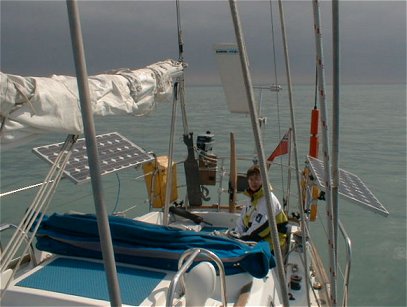 |
| Our solar panels can provide up to 9 amps between then in full, direct sunlight |
Conservation of precious electrical resources is definitely the first step. The Tillys are brilliant in this respect (literally too!). They need a bit of maintenance though. Many dealers sell mantles alongside their stock of lamps, but in our experience, although these are fragile they are not usually the problem. The problem is often the microscopic hole in the top of the vapouriser, the metal tube that carries the paraffin up to the light. The size of this hole is critical and it is so small as to be un-maintainable with normal tools. A regular replacement of this metal item is often all it takes to tame a lamp that's getting difficult.
Hanging the lamps from the deck-head is also a wise step, especially on a rolly anchorage, but they give a lot of heat and could easily burn the ceiling. A length of metal chain about 6 inches (15 cm) long can be threaded onto the handle and provides a safe distance for the heat to disperse. Don't use string as I am sure the heat could melt polyester and the thought of a pressurised lamp crashing to the floor is just too awful to think about. A length of cord bowlined around the bottom of the lamp can prevent it swinging out of control if the rolling gets worse.
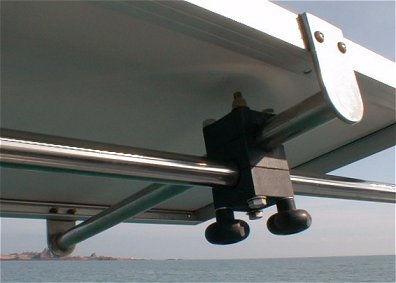 |
| This arrangement of stainless-steel tubes and glass-filled nylon clamps I designed to allow as many degrees of freedom as possible for the solar panels, at sea, at anchor and in harbour. |
We do not use the Tillys while under way, although some people do. They also do not help with the television, the fridge, the SSB transceiver, the computer or the radar, which are the most power-hungry items on board. The options are as follows:
We all have one of these on the auxiliary diesel. There are a few options to reduce unnecessary running hours just to recharge the batteries:
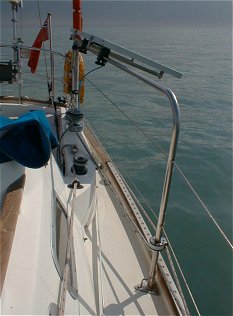 |
| Stainless-steel work replaced the aft stanchion each side and linked it to the pushpit with a new rail. This provides a mount for the panels as well as making the whole cockpit more secure. The panels also provide wind and sun shelter to those on watch. |
These are de rigour on many cruising boats, often to be seen high up on the mizzen mast of a long-distance ketch. We have no mizzen mast, so would need a dedicated pole alongside the cockpit.
There were a number of problems with this. For one thing, where to mount it, keeping it away from the wind-vane steering, the twin backstays and maintaining a clear space on the port side in case a helicopter air-lift was ever necessary? There is also the worry I have about things which become more and more dangerous, just when you don't want them to. In a rising gale those whirling blades would always look increasingly dangerous just above our heads. Suppose the pole bent or became dislodged? What if a blade began to shred itself or just flew off?? I could never sit underneath a thing like that and feel secure in a blow. Then there's the noise - we have been very aware of the noise of other boats' wind-mills in a windy anchorage - what must it be like to have one fixed to your own hull? The cabin would never be a quiet place again.
These are obviously only of any use when under way, and they do reduce your speed by maybe half or one knot, but I have heard good stories about them and we may succumb to one yet. One problem is that you can't tow one of these and a Walker's Log, to measure distance travelled accurately, at the same time. (Well maybe sometimes you have to decide on priorities). You can get them that can be converted to wind-power and hoisted in the rigging when you get there.
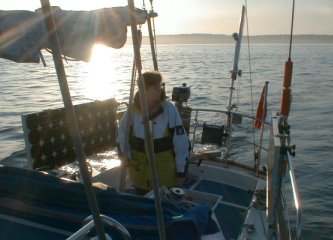 |
| Swung in-board like this the solar panels are relatively safe for the trials of manoeuvring in confined marinas. They are fronted with high-quality toughened glass as well! |
I did look into trying to rig something to the existing prop-shaft, which turns relentlessly while we sail. I don't know what power would be available as obviously the propeller is not optimised for this use. The main problems, however, were accommodating the flexible, rubber mounting of the whole engine and the wear that the belt-tension would cause in the prop-shaft bearings.
No moving parts, silent, maintenance-free... The first problem is the size and weight of the things. Where to mount them? Huge advances in efficiency have been made in recent years, and so the idea is feasible now. Thin, flexible panels have not got the same efficiency as rigid, glass-fronted ones so that limits you a bit. The second problem is orientation to catch the best of the sun wherever it may be in relation to the boat.
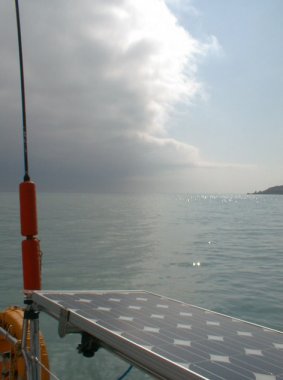 |
| There is no doubt that direct, full sunlight is necessary for the panels to work at their full power. Any shadows or cloud and their output drops dramatically. Here the sun is just coming out and they are just about to begin to earn their keep. |
I hope that the photos on this page show my solution adequately. I had to have two new rails welded to the pushpit to provide the height. They also increase the security of the cockpit area. I designed and made the black plastic clamps myself (glass-filled UV-proof nylon). One-inch stainless-steel bars had to be made up to screw to the panels to fit it all together. The panels provide up to 9 amps between them in full sun and I have wired them through a smart regulator to charge the two house batteries even when the main circuits are switched off (They have their own switches too).
The mountings allow them to be angled in many directions and they have been no problem at anchor, in marinas or under full sail. The rails are not strong enough to allow the panels to take the full weight of waves aboard in a storm and this is the only problem. They would need to be unclamped and stowed below on receipt of a forecast of, say Force 8 or more. They are heavy and the clamps are fiddley so this could be a challenge in a rising gale. Down below they would need a sea-berth with lee-cloth all to themselves, so Nicky and I would have to hot-bunk the other until they could be put out again. They provide us with loads of power and as long as we are sensible, have always met our needs so far.